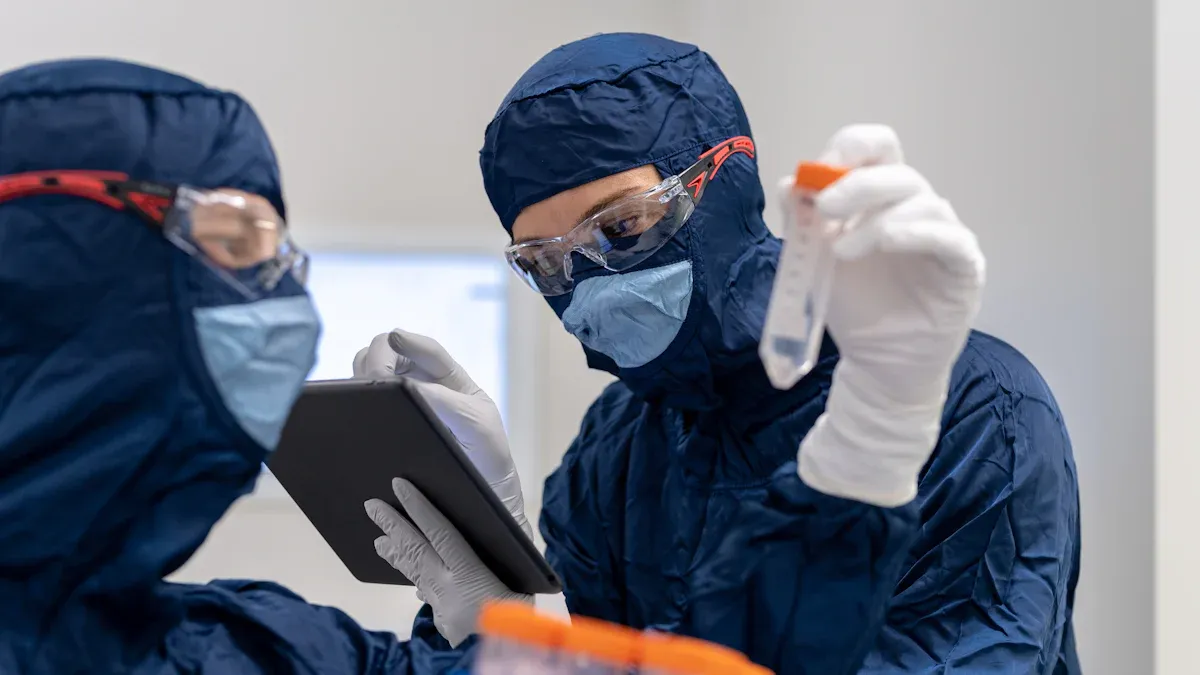How PET Heat Shrink Tubing Protects and Strengthens Medical Equipment

PET heat shrink tubing enhances medical equipment by adding protection and durability. It acts as an insulating layer, shielding devices from electrical interference. Its mechanical strength prevents wear and tear, ensuring longevity. This tubing also supports biocompatibility, making it suitable for medical applications. Devices that rely on PET Tubing for Biocompatible Applications benefit from its safe and reliable performance. The unique properties of this material make it an essential component in advancing medical technology.
By integrating PET heat shrink tubing, manufacturers can improve the safety and reliability of medical equipment.
Key Takeaways
PET heat shrink tubing protects medical devices from damage and lasts long.
This tubing insulates well, stops electrical problems, and keeps equipment safe.
PET tubing is safe for the body, so it works well in medical tools.
Picking the right size and type of PET tubing is important for it to work properly and meet medical rules.
Buying from trusted sellers ensures the tubing is safe and reliable for medical use.
Overview of PET Heat Shrink Tubing
What is PET heat shrink tubing?
PET heat shrink tubing is a specialized material designed to provide protection and insulation for various applications, including medical equipment. PET, or polyethylene terephthalate, is a thermoplastic polymer known for its strength, flexibility, and resistance to environmental factors. When exposed to heat, this tubing shrinks to fit tightly around objects, creating a secure and protective layer. Its ability to conform to different shapes and sizes makes it a versatile solution for safeguarding delicate components in medical devices.
Material properties of PET tubing
PET heat shrink tubing exhibits several unique material properties that make it ideal for medical applications. It offers excellent tensile strength, ensuring durability under mechanical stress. Its resistance to moisture, chemicals, and high temperatures enhances its performance in demanding environments. Additionally, PET tubing maintains its clarity and flexibility even after repeated sterilization processes, making it suitable for use in sterile medical settings. These properties ensure that PET heat shrink tubing can withstand the rigorous conditions often encountered in healthcare environments.
PET tubing for biocompatible applications
PET tubing for biocompatible applications plays a critical role in ensuring patient safety and device reliability. The ultra-thin PET heat shrink tubing is made from non-toxic materials, reducing health risks for patients and healthcare professionals. It complies with rigorous medical standards, guaranteeing its suitability for use in sensitive medical procedures. The absence of harmful chemicals in the tubing enhances overall treatment outcomes by minimizing the risk of adverse reactions. These qualities make PET tubing an essential component in advancing medical technology while prioritizing patient well-being.
Key Benefits of PET Heat Shrink Tubing

Insulation and electrical protection
PET heat shrink tubing provides exceptional insulation, making it a vital component in medical equipment. It prevents electrical interference by creating a protective barrier around sensitive components. This insulation ensures that devices operate without disruptions, even in environments with high electromagnetic activity. The tubing also reduces the risk of short circuits, enhancing the safety of medical devices. Its ability to maintain consistent performance under varying conditions makes it a reliable choice for insulation needs.
In addition to electrical protection, PET heat shrink tubing offers thermal insulation. It shields components from temperature fluctuations, ensuring stable operation. This dual insulation capability supports the longevity and reliability of medical equipment, even in demanding healthcare settings.
Mechanical protection and durability
The mechanical strength of PET heat shrink tubing safeguards medical devices from physical damage. Its robust structure resists abrasion, punctures, and impacts, protecting delicate components. This durability ensures that devices remain functional, even when subjected to repeated use or harsh conditions.
The tubing also enhances the structural integrity of medical equipment. By providing a secure and tight fit, it prevents components from shifting or loosening over time. This added stability contributes to the overall durability of the device.
Moreover, PET heat shrink tubing withstands repeated sterilization processes without degrading. Its resistance to wear and tear ensures that medical devices maintain their performance and safety standards throughout their lifespan.
Biocompatibility and safety
Biocompatibility is a critical factor in medical applications, and PET heat shrink tubing excels in this area. Its non-toxic composition minimizes the risk of adverse reactions, ensuring patient safety. The tubing complies with stringent medical standards, making it suitable for use in sensitive procedures.
The smooth surface of PET heat shrink tubing reduces the likelihood of bacterial growth, further enhancing safety. Its ability to maintain cleanliness and sterility supports its use in environments where hygiene is paramount.
By combining biocompatibility with mechanical and electrical protection, PET heat shrink tubing plays a crucial role in advancing medical technology. Its unique properties ensure that medical devices meet the highest standards of safety and reliability.
Resistance to chemicals and sterilization
PET heat shrink tubing demonstrates exceptional resistance to chemicals and sterilization processes, making it indispensable in medical environments. Its ability to endure exposure to harsh cleaning agents and disinfectants ensures the longevity of medical devices. This resistance plays a vital role in maintaining the functionality and safety of equipment used in healthcare settings.
Medical devices often encounter rigorous cleaning routines and sterilization procedures. PET heat shrink tubing withstands these processes without compromising its structural integrity. Its durability ensures that devices like catheters and monitoring cables remain reliable even after repeated exposure to chemicals and UV radiation.
Key attributes of PET heat shrink tubing include:
Resistance to cleaning agents, solvents, and disinfectants commonly used in medical facilities.
Ability to endure UV radiation without degradation.
Maintenance of structural integrity during sterilization processes.
These properties make PET heat shrink tubing a preferred choice for applications requiring high durability and chemical resistance. Its performance ensures that medical devices retain their protective qualities, even in demanding environments.
The tubing’s resilience also supports its use in devices subjected to frequent handling and sterilization. By preserving the integrity of sensitive components, PET heat shrink tubing contributes to the reliability and safety of medical equipment.
Applications of PET Heat Shrink Tubing in Medical Equipment

Catheters and guidewires
PET heat shrink tubing plays a vital role in the production of catheters and guidewires. These devices require precise insulation and protection to function effectively in medical applications. The tubing provides a smooth, biocompatible surface that minimizes friction during insertion. This feature enhances patient comfort and reduces the risk of tissue damage.
The tubing also ensures the structural integrity of catheters and guidewires. Its mechanical strength prevents wear and tear, even during repeated use. Additionally, PET heat shrink tubing resists exposure to bodily fluids and sterilization processes, maintaining its performance over time. Manufacturers like AccuPath supply high-quality tubing that meets the stringent requirements of these critical devices.
Surgical instruments
Surgical instruments benefit significantly from the use of PET heat shrink tubing. The tubing acts as a protective layer, shielding delicate components from damage during use and sterilization. Its resistance to chemicals and high temperatures ensures that instruments remain functional and safe for repeated procedures.
The tubing also enhances the grip and handling of surgical tools. By providing a non-slip surface, it allows surgeons to maintain precision during operations. This feature is particularly important in procedures requiring fine motor skills. AccuPath offers PET heat shrink tubing tailored to meet the specific needs of surgical instruments, ensuring reliability and durability in demanding environments.
Electronic medical devices
Electronic medical devices rely on PET heat shrink tubing for insulation and protection. The tubing prevents electrical interference, ensuring that devices operate accurately and safely. It also shields sensitive components from moisture, chemicals, and physical damage.
In addition to its protective properties, PET heat shrink tubing contributes to the miniaturization of electronic medical devices. Its ability to conform tightly to components allows manufacturers to design compact and lightweight equipment. This feature is essential for portable and wearable medical devices.
AccuPath specializes in providing PET heat shrink tubing that meets the high standards of electronic medical devices. Their products ensure optimal performance and longevity, making them a trusted partner for manufacturers in the healthcare industry.
Diagnostic tools
PET heat shrink tubing plays a crucial role in enhancing the performance and reliability of diagnostic tools. These tools, which include imaging devices, probes, and sensors, require precise protection and insulation to deliver accurate results. PET tubing ensures that these devices function optimally, even in challenging medical environments.
One of the primary benefits of PET heat shrink tubing in diagnostic tools is its ability to provide electrical insulation. Many diagnostic devices rely on sensitive electronic components to capture and process data. PET tubing creates a protective barrier around these components, preventing electrical interference and ensuring consistent performance. This insulation is particularly important in tools like ultrasound probes and electrocardiogram (ECG) sensors, where even minor disruptions can compromise diagnostic accuracy.
Tip: PET heat shrink tubing's ability to conform tightly to irregular shapes makes it ideal for protecting complex diagnostic equipment.
In addition to insulation, PET tubing offers mechanical protection. Diagnostic tools often undergo frequent handling and exposure to physical stress. PET tubing resists abrasion, impacts, and wear, safeguarding delicate components from damage. For example, in endoscopic devices, the tubing protects the internal wiring and optical fibers, ensuring the tool remains functional during repeated use.
The tubing's chemical resistance further enhances its suitability for diagnostic tools. Medical environments require rigorous cleaning and sterilization to maintain hygiene. PET heat shrink tubing withstands exposure to harsh disinfectants and sterilization processes without degrading. This durability ensures that diagnostic devices remain safe and effective over time.
Key advantages of PET heat shrink tubing for diagnostic tools include:
Enhanced durability: Protects against physical damage and wear.
Chemical resistance: Maintains integrity during cleaning and sterilization.
Biocompatibility: Ensures safety for patients and healthcare professionals.
PET tubing also supports the miniaturization of diagnostic tools. Modern medical technology increasingly demands compact and portable devices. PET heat shrink tubing's ability to conform tightly to components allows manufacturers to design smaller, more efficient tools. This feature is particularly valuable in wearable diagnostic devices, where size and weight are critical factors.
By combining protection, durability, and adaptability, PET heat shrink tubing has become an indispensable component in diagnostic tools. Its unique properties ensure that these devices meet the high standards of accuracy and reliability required in medical settings.
Selection Criteria for PET Heat Shrink Tubing
Size and fit considerations
Selecting the correct size and fit for PET heat shrink tubing is essential for optimal performance. The tubing must shrink uniformly to create a secure and protective layer around the medical device. Manufacturers should measure the dimensions of the components carefully to ensure a precise fit. Tubing that is too loose may fail to provide adequate protection, while tubing that is too tight could damage delicate components during the shrinking process.
The shrink ratio of the tubing is another critical factor. PET heat shrink tubing typically comes in various shrink ratios, such as 2:1 or 4:1, which indicate how much the tubing can reduce in size. Devices with irregular shapes or varying diameters may require tubing with a higher shrink ratio for proper coverage. By considering these factors, manufacturers can ensure that the tubing meets the specific requirements of their medical equipment.
Material quality and performance
The quality of the PET material directly impacts the performance of the heat shrink tubing. High-quality PET tubing offers superior tensile strength, chemical resistance, and thermal stability. These properties ensure that the tubing can withstand the demanding conditions of medical environments, including exposure to sterilization processes and harsh cleaning agents.
Manufacturers should prioritize tubing that complies with medical-grade standards. Certifications such as ISO 10993 for biocompatibility and USP Class VI for material safety indicate that the tubing is suitable for use in medical applications. Additionally, the tubing should maintain its clarity, flexibility, and structural integrity over time. Choosing high-performance materials ensures that medical devices remain safe and reliable throughout their lifespan.
Supplier reliability
The reliability of the supplier plays a crucial role in the selection process. Reputable suppliers often adhere to strict regulatory compliance frameworks, such as FDA and CE certifications. These certifications demonstrate the supplier's commitment to quality and safety, which is essential for medical applications.
Suppliers who successfully navigate certification processes gain a competitive edge in the market. Their ability to meet stringent standards ensures the integrity of the materials they provide. On the other hand, non-compliance can lead to significant financial losses, including product recalls and damage to brand reputation.
Key factors to evaluate when assessing supplier reliability include:
Regulatory compliance: Look for suppliers with FDA and CE certifications.
Market reputation: Choose suppliers known for delivering consistent quality.
Customer trust: Reliable suppliers often enjoy long-term partnerships with leading manufacturers.
By selecting a trustworthy supplier, manufacturers can ensure that their PET heat shrink tubing meets the highest standards of quality and performance.
Compliance with medical standards
PET heat shrink tubing must meet stringent medical standards to ensure its suitability for healthcare applications. Compliance guarantees that the tubing performs reliably and safely in environments where patient health is at stake. Manufacturers prioritize adherence to these standards to maintain the integrity of medical devices.
Key Standards for Medical Applications
Several regulatory frameworks govern the use of PET heat shrink tubing in medical equipment:
ISO 10993: This standard evaluates the biocompatibility of materials used in medical devices. PET tubing undergoes rigorous testing to confirm that it does not cause adverse reactions when in contact with human tissue.
USP Class VI: This certification ensures that the tubing is free from harmful chemicals and safe for prolonged use in medical environments.
FDA Approval: PET tubing must comply with FDA regulations to be used in medical devices sold in the United States.
Note: Compliance with these standards demonstrates the tubing’s ability to meet the highest safety and performance requirements.
Importance of Compliance
Meeting medical standards ensures that PET heat shrink tubing performs consistently under demanding conditions. It minimizes risks such as chemical leaching, mechanical failure, or electrical interference. Compliance also supports the sterilization processes required in healthcare settings, ensuring that devices remain safe for repeated use.
Benefits for Manufacturers
Manufacturers gain several advantages by using compliant PET heat shrink tubing:
Benefit | Description |
|---|---|
Enhanced Safety | Reduces risks associated with non-compliant materials. |
Regulatory Approval | Facilitates market entry in regions with strict medical device regulations. |
Customer Trust | Builds confidence among healthcare providers and patients. |
By adhering to medical standards, PET heat shrink tubing ensures reliability, safety, and long-term performance in critical medical applications.
PET heat shrink tubing has become a cornerstone of modern medical equipment due to its unmatched protection, durability, and biocompatibility. Its ability to enhance safety and reliability ensures that medical devices meet the highest standards. Emerging trends, such as custom solutions tailored to specific applications, further improve functionality. Sustainability also plays a growing role, with eco-friendly materials gaining traction. Additionally, advancements like sensor-embedded tubing enable real-time monitoring, boosting device safety and efficacy. By selecting the right PET heat shrink tubing, manufacturers can drive innovation while maintaining compliance with medical standards.
FAQ
What makes PET heat shrink tubing suitable for medical devices?
PET heat shrink tubing offers durability, biocompatibility, and resistance to chemicals and sterilization. These properties ensure it performs reliably in medical environments. Its ability to conform tightly to components enhances protection and safety, making it ideal for healthcare applications.
Can PET heat shrink tubing be used with irregularly shaped components?
Yes, PET heat shrink tubing adapts to irregular shapes due to its shrink ratio. Manufacturers can select tubing with higher shrink ratios, such as 4:1, to ensure a secure fit around components with varying diameters or complex designs.
How does PET heat shrink tubing support sterilization processes?
PET heat shrink tubing withstands high temperatures, UV radiation, and exposure to harsh disinfectants. These qualities allow it to maintain its structural integrity during repeated sterilization cycles, ensuring medical devices remain safe and effective for long-term use.
Is PET heat shrink tubing environmentally friendly?
PET is recyclable, making it a more sustainable choice compared to other materials. Some manufacturers also offer eco-friendly options, aligning with the growing demand for environmentally conscious medical device components.
What certifications should PET heat shrink tubing have for medical use?
Medical-grade PET heat shrink tubing should comply with ISO 10993 for biocompatibility, USP Class VI for material safety, and FDA regulations. These certifications ensure the tubing meets stringent safety and performance standards required in healthcare settings.
See Also
The Importance of Ultra-Thin PET Tubing in Medicine
Advantages of FEP Heat Shrink Tubing for Healthcare
Essential Information on PET Heat Shrink Tubing for Electronics

